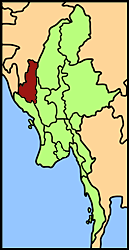Lai people
The Lai people
Demography
The total
The community is scattered in different parts of the world, mainly concentrating in Mizoram (Khuafo and Thlantlang/Tuichhak Pawih),
Chin States

- Zomi 344,000 speakers
- Falam Chinan estimated 107,300 speakers
- Hakha Chin 125,000 speakers
- Matu Chin 100,000 speakers
"Each dialect is so distinct that people who speak different dialects will not likely understand each other".[8]
Ethnic origin
The Lai who are living in the
The Lai are also believed to be from the main tree of the
Subtribes
There are many tribes among the Chin people which includes Laimi, Matu, Asho, Cho (Sho), Khuami (M'ro), lusei (Lushai), Kuki (Thadou) and Zomi . In each of these tribe group there are many sub-tribes groups. The sub-tribes of Laimi are: Laizo, Khuangli, Khualsim, Zahau, Zanngiat, Lente, Ngawn, Tlanglau, Dawn, Thlanrawn, Tlaisun, Hauhulh, Zokhua, Simhrin, Mi-E and Towr.[6]
Culture
Chin National Day
Chin National day is celebrated each year on 20 February to commemorate the "General Assembly of Chinland" held in 1948.[10] The first Chin National day was held on 20 February 1951 in Mindat Town and was attended by U Nu, the first Prime Minister.[11] During the holiday, people from different ethic group display Rua Khua Tlak (bamboo dance), Khuang Cawi (lifting of decorative bamboo lifter), Sarlam (dance of the conquest), Rallu lam (Mizo dance) and many other dances and events. Some of the big events are fashion show, Miss competition and Laipaih (wrestling). The strongest laipaih or Chin wrestler from this generation is Rung Lian Ceu, he was from Chuncung town, and he is currently living in the United States.[12]
Clothing
There are many different traditional clothing such as
Greeting
The normal handshake is a common greeting in Chin cultures
Sports
The most common sports for the Laimi are soccer (football), volleyball, and wrestling.
Religion
The first Christian missionaries were Arthur Carson and his wife Laura arrived Hakha on 15 March 1899. Today, the majority of Chin are Christian.
| Religion in Chin (2014)[14] | % |
|---|---|
| Christian | 85.4% |
| Buddhist | 13.0% |
| Animist | 0.4% |
| Islam | 1.1% |
| Other religion | 1.1% |
Notes
References
- ^ Pau, Indo-Burma Frontier and the Making of the Chin Hills (2019), pp. 15–16.
- ^ Dun, Gazetteer of Manipur (1886), p. 32.
- ^ Pau, Indo-Burma Frontier and the Making of the Chin Hills (2019), pp. 15–16: "The Hakas, Thantlangs, Zokhua, Thettas, Kapis and so forth populated the Haka area. The Hakas and the Thantlangs called themselves Lai/Laimi, and they are similar to the Shindu/Shendu/Mara/Lakher of the British records from the Chittagong and Arakan Hill Tracts.".
- ISBN 9781315399492
- ^ Lalthangliana, B.: History and Culture of Mizo in India, Burma and Bangladesh, 2001. RTM Press. Aizawl. pp. 101–102.
- ^ a b c ""We Are Like Forgotten People" | The Chin People of Burma: Unsafe in Burma, Unprotected in India". Human Rights Watch. 27 January 2009. Retrieved 17 March 2020.
- ^ yi, H.E. U Khun (May 2015). "The 2014 Myanmar Population and Housing Census" (PDF). Myanmar.unfpa.org. Retrieved 16 March 2020.
- ^ a b "Chin Cultural Profile – EthnoMed". ethnomed.org. Retrieved 17 March 2020.
- ^ "Burmese and Chin Languages". help.daytranslations.com. Retrieved 17 March 2020.
- ^ "CHIN IDENTITY AND CHIN NATIONAL DAY – Chin Community in Norway". Retrieved 17 March 2020.
- ^ "How Came Our Chin National Day (February 20, 1948) ~ Khup Khan Thang". ZOMI DAILY. 17 February 2019. Retrieved 17 March 2020.
- ^ "Rung Lian Ceu Thawnnak". 7 January 2018. Archived from the original on 21 December 2021. Retrieved 16 March 2020 – via YouTube.
- ^ Peacock, Andrew. "The Chin - A Cultural Profile". storage.cloversites.com. Retrieved 16 March 2020.
- ^ Swe, Thein (July 2016). "The 2014 Myanmar Population and Housing Census" (PDF). Myanmar.unfpa.org. Retrieved 17 March 2020.
Bibliography
- Dun, E. W. (1992) [1886], Gazetteer of Manipur, Manas Publications – via archive.org
- Pau, Pum Khan (2019), Indo-Burma Frontier and the Making of the Chin Hills: Empire and Resistance, Taylor & Francis, ISBN 9781000507454

